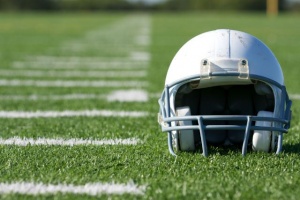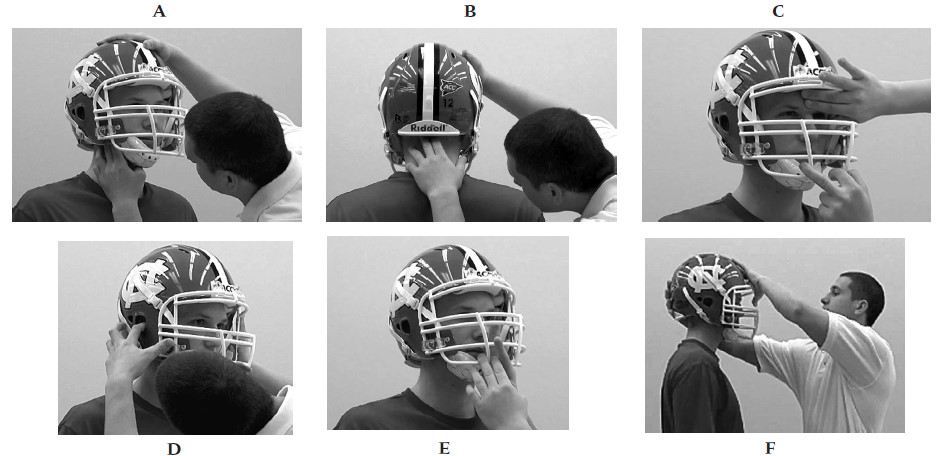Protective Sports Equipments
Introduction[edit | edit source]
One of the most important aspects in sports medicine and in prevention of athletic injuries is protective gears. Physical therapist's role is to ensure safety, prevention of injuries and protecting existing injuries.
Protective Materials[edit | edit source]
Highly resilient materials are used when protection from repeated impacts is required. Non-resilient materials can be used when one time or occasional impact is expected. Different types of protective materials include:
- Foam – Two main type: open-cell and closed-cell. Open-cell foams are low density materials, have the capacity to absorb fluids and are commonly used to pad bony prominences or hard edges of protective equipment. Open-cell do not have good shock absorbing qualities. Closed-cell has superior shock absorbing abilities, resilience to absorption of fluid and is more preferred.
- Air management pads are relatively new type used when maximal shock absorption is required in lightweight gear.
- Gel like Orthogel is useful in absorbing shock. Gel is useful for protecting bony areas such as the foot, hand and AC joint. It can be cut as a horseshoe pad to treat ankle sprain, which can be used with cryotherapy. Lack of longevity is draw-back associated with gel.
- Felt is extremely useful for creating various types of supports and protective pads. It is used for arch supports and as horseshoe to reduce edema to treat ankle sprain.
- Thermoplastics can be used for splints and custom pad. It can be divided into plastic and rubber. Plastic is more appropriate for small splints, such as on the hand. Working temperature for this materials range from 150 to 180 degrees F.
- Casting material like silicone elastomer is popular in fabricating soft splints for hands or wrist injuries.
Head Protection[edit | edit source]
List of sports requiring head protection include: Amateur boxing, baseball, cycling, football, ice hockey, men’s’ lacrosse, softball, and
whitewater sports.
Football Helmet
- Athlete should be aware of inspection of helmet before usage as: Check foam padding for proper placement and any deterioration. Check for cracks. Check for any alteration. Check for inflation in air-padded helmets. Check fastening.
- A helmet is not legal for use if the warning label adopted by NOCSAE is not visible.
- Revolution helmet by Riddell has shown to reduce the risk of concussion by as much as 31 percent.
- Helmet fitting – Athlete should wet the hair (to simulate sweat) or wear the hair the way it will be worn during the season during helmet fitting. (A) Should fit snugly. (B) Should cover the base of the skull. (C) Should not come down over the eyes. (D) Ear holes should line up external ear canals. (E) Face mask should not move with external force. Four-snap chin strap keeps the helmet from tilting forward and backward. (F) Shoulder not shift when manual pressure is applied.
Ice Hockey Helmet – Must only absorb singular as opposed to multiple impacts in football. Helmet should also protect the head from low-mass, high-velocity impact forces (like hit with stick or puck) in addition to high-mass, low velocity (like fall). Must be certified by Canadian standards association (CSA). Use of full-face shield reduces the number and severity of facial injuries.
Baseball Helmets – should absorb high-velocity impacts. Ability to prevent head injury is questionable.
Face Protection[edit | edit source]
Face guards
- Main purpose is to protect against projectile, carried objects and collisions with other players.
- Junior A hockey players wearing no face visor were 4.7 times more likely to suffer eye and face injuries.
- NCAA require goal keepers to wear throat protection as well as face protection.
- Men’s lacrosse rule mandate helmets and face masks with a NOCSAE standard.
Chin Straps
- Single strap allows some rotation of the helmet but is usually adequate in maintaining the appropriate position of the helmet on the top of the head. Used in sports like cycling and kayaking.
- Four-point chin strap used in sports like football and lacrosse, which are secured by either the high hookup or the low hookup. Decrease the angle of low hookup means that there is less chance of the chin strap rotating off the chin.
Eye and Ear Protection[edit | edit source]
Eye Protection
- Special precautions should be taken in sports like ice hockey, men’s and women’s lacrosse, baseball, basketball, squash and handball.
- Types of eye protectors: Total head protector (used in football, lacrosse, hockey), full-face protector (used in fencing, catching or umpiring), separate eye protector (used in ski racing, auto racing, cycling, and horseback riding), Partial eye protection (used in boxing). Sports eye protectors (used in baseball, soccer, cross country skiing).
- Sports eye protector: Class I – a molded single unit lens and frame, Class II – lens mounted in a separate frame, Class III – protector that contains no lens that is used alone or over eyeglasses.
- Use of goggles in women’s lacrosse became mandatory in 2004.
- Eye protectors with shatterproof polycarbonate or CR 36 prescription lenses give good protection during sports activities.
- “One-eyed” Athlete – Athlete is considered “one-eyed” if the corrected vision is 20/200 or less in one eye. Athlete should not participate in extremely high risk sports like boxing.
Ear Protection
- “Cauliflower Ear” – Hematoma in the outer ear, may occur without use of appropriate equipment.
- Ear protection is required in sports like boxing, wrestling, and water polo, because of high incidence of ear injury in these sports.
Mouth Guard[edit | edit source]
- NCAA require participants to wear mouth guards for the sports such as football.
- Types of mouth guard: “boil and bite” and custom-made.
- Studies suggests that mouth guards do not prevent or reduce the incidence of concussions.
- No significant difference between “boil and Bite” mouth guard and manufactured one.
- Simple “boil and bite” mouth guards are effective and can be bought in bulk to fit an entire team.
- Mouth guards should fit comfortably, not impede speech or breathing, and should extend back as far as last molar.








